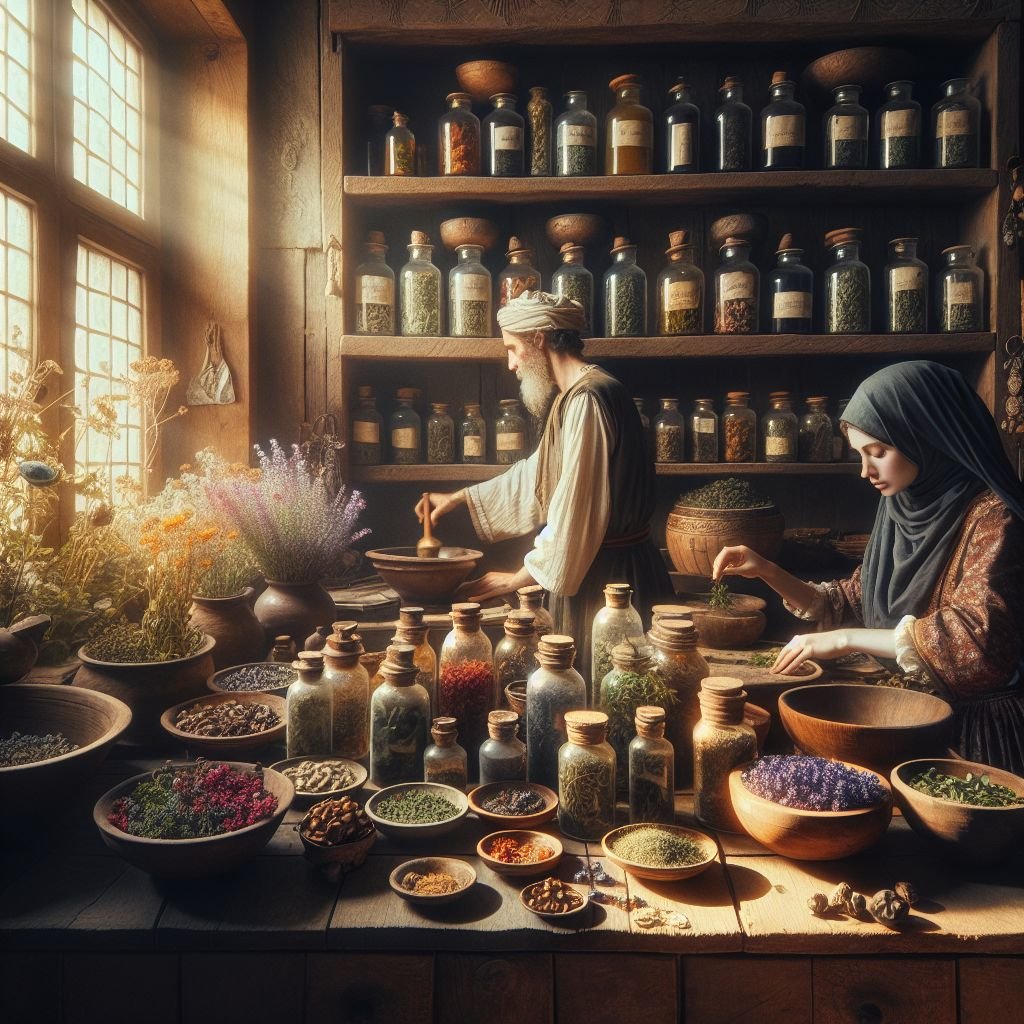When it comes to nurturing a garden that goes beyond beauty to offer tangible health benefits, nothing compares to the power of medicinal herbs. These plants are not just a feast for the eyes; they’re a boon for the body, offering remedies for ailments ranging from the common cold to digestive discomfort. Whether you’re a seasoned gardener or just starting out, the right selection of herbs can transform your green space into a sanctuary of healing.
Key Takeaways
- Selecting the right medicinal herbs for your garden depends on your specific health needs and gardening conditions.
- Some of the most beneficial and easy-to-grow medicinal herbs include lavender, chamomile, and mint.
- Preparing the soil correctly and understanding each herb’s sunlight needs are crucial steps in establishing a successful medicinal garden.
- Regular maintenance, such as weeding and pruning, will keep your herbs healthy and potent.
- Harvesting at the right time ensures you get the most effective medicinal properties from your plants.
A Potent Patch: Selecting Medicinal Herbs for Your Garden
Let’s start by figuring out which herbs to invite into your garden. You’ll want to consider not just what ails you, but also the conditions your garden can provide. Some herbs thrive in full sun, while others prefer a bit of shade. The soil in your garden can make a difference, too – some herbs like it dry, while others need a bit more moisture.
Criteria for Choosing Medicinal Herbs
When picking out plants for your medicinal garden, think about what health issues you’d like to address. Are you looking for herbs that can help soothe anxiety, such as lemon balm or valerian? Or maybe you need something for digestive health, like peppermint or ginger. Also, consider the space you have available – some herbs, like echinacea, can grow quite large, while others, like thyme, are more compact.
Top Herbs for Diverse Remedies
Now, let’s talk about some top herb choices that can cater to a variety of health needs:
| Herb | Properties |
|---|---|
| Lavender | Calming scent, soothes skin irritations |
| Chamomile | Relaxing, stress relief, gentle sleep aid |
| Mint | Refreshing flavor, aids digestion, relieves headaches |
| Echinacea | Boosts immune system, effective during cold and flu season |
| Calendula | Healing cuts and scrapes, bright blooms |
Planting Your Medicinal Garden: A Step-by-Step Guide
With your selection of herbs in mind, it’s time to roll up your sleeves and get planting. But before you start, there’s some groundwork to be done – literally. Preparing the soil for your medicinal plants is a critical first step that will ensure your garden thrives.
- First, you’ll need to assess the quality of your soil. Is it sandy, clay-heavy, or just right? This will determine what amendments you might need.
- Next, consider the pH level. Most herbs prefer a neutral to slightly alkaline soil.
- Then, get your hands dirty and work in some organic matter, like compost, to give your herbs a nutrient-rich start.
And remember, when you’re planning where to plant, think about sunlight. Most medicinal herbs love the sun, so find a spot where they’ll get plenty of it. But if your garden has shadier areas, don’t worry – herbs like lemon balm and mint can still flourish there.
Understanding Soil and Sunlight Needs
Each herb has its own preference for soil and sunlight. For example, lavender loves well-draining soil and full sun, while parsley will do better in rich, moist soil with a bit of afternoon shade. Getting to know the specific needs of each herb will go a long way in ensuring your garden’s success.
Herb Planting Techniques for Success
When it comes to planting, you’ve got options. You can start from seeds, which is a more economical choice but requires patience as they grow. Alternatively, you can buy young plants, which is a bit more expensive but gives you a head start. Whichever route you choose, make sure to give your herbs enough space to spread out and grow. And when you’re planting, be gentle – these are living things, after all!
Here’s a quick rundown:
- Starting from seeds: Sow them in well-prepared soil, following the depth and spacing recommendations on the seed packet.
- Planting seedlings: Dig a hole that’s just the right size for the root ball, place your plant in gently, and fill in with soil.
- Watering: Give your new plants a good drink, but don’t overdo it. Herbs don’t like to sit in soggy soil.
Now, with your herbs happily in the ground, let’s look ahead to keeping them healthy and vibrant.
Caring for Your Herbal Oasis
Once you’ve planted your herbs, the journey to a lush and therapeutic garden is just beginning. The care you give your plants is what will make the difference between a struggling patch and a vibrant, healing space. It’s not just about watering and waiting; it’s about creating the perfect environment for your herbs to thrive.
Consistent attention is key. Just like us, plants need a balanced diet and the right amount of water and sunlight to stay healthy. You’ll want to keep an eye out for any changes in your plants that might indicate they need a little extra TLC. But don’t worry, I’ll guide you through the essentials of herb garden maintenance, so you can keep your plants in tip-top shape.
- Water your herbs deeply but infrequently to encourage strong root growth.
- Prune regularly to promote bushy growth and prevent your herbs from getting leggy.
- Keep an eye out for yellowing leaves, which can indicate overwatering or poor drainage.
- Feed your herbs with a balanced, organic fertilizer to ensure they get all the nutrients they need.
Herbs are generally low-maintenance, but they do have some needs that must be met if they’re to provide you with their best healing properties. Remember, a little effort goes a long way in the garden.
Essential Tips for Herb Garden Maintenance
As your herbs grow, they’ll need some upkeep to stay healthy. Regular weeding is a must – weeds can steal nutrients and water from your herbs. Mulching can help reduce the number of weeds and also maintain soil moisture. When it comes to pruning, don’t be shy. Cutting back your herbs can actually stimulate new growth and lead to a fuller plant.
Most importantly, be mindful of your herbs’ water needs. Overwatering can be just as harmful as not watering enough. Many medicinal herbs come from Mediterranean climates and are used to drier conditions, so let the soil dry out a bit between waterings.
- Monitor soil moisture – it should be moist, not soggy or bone dry.
- Prune your herbs to encourage growth; this means cutting back flowering tops on herbs like mint to promote more leafy growth.
- Mulch around your plants to conserve water and suppress weeds.
With these simple but effective practices, your medicinal herb garden will not only survive but thrive, providing you with an abundance of health-promoting plants.
Common Pests and Problems to Watch For
Your medicinal herbs may face threats from pests like aphids, spider mites, and caterpillars. These little critters can do a lot of damage if left unchecked. The key to managing pests is to keep a close eye on your plants and act quickly if you spot any signs of infestation, such as chewed leaves or sticky residue.
Another issue to be aware of is plant diseases, which can spread quickly in the right conditions. Fungal diseases like powdery mildew can be a problem, especially if your plants are too close together and have poor air circulation.
Natural Solutions for Herb Garden Health
Thankfully, there are plenty of natural ways to deal with pests and diseases. For example, a simple spray made from water and a few drops of dish soap can deter aphids. Neem oil is another great organic option for controlling pests and preventing fungal diseases. And encouraging beneficial insects, like ladybugs and lacewings, can help keep the pest population in check.
Prevention is always better than cure, so make sure to plant your herbs with enough space for air to circulate, and keep the area around them clear of debris where pests could hide.
Harvesting Herbs: Timing and Techniques
The moment when you harvest your herbs can have a big impact on their medicinal qualities. Most herbs are at their peak just before they flower, when their oils and flavors are most concentrated. This is the perfect time to gather them for use in teas, tinctures, and salves.
When you do harvest, do so in the morning after the dew has dried but before the sun is high. This helps ensure that you’re capturing the herbs at their most potent.
Knowing When to Harvest for Peak Potency
Understanding the life cycle of your herbs is crucial for harvesting at the right time. For example, annual herbs like basil are best harvested before they go to seed, while perennials like oregano can be harvested multiple times throughout the growing season.
Look for signs that your herbs are ready to be picked, such as vibrant color and a strong aroma. And don’t forget, regular harvesting can encourage new growth, so don’t be afraid to snip away.
Best Practices for Cutting and Storing Herbs
When you’re ready to harvest, use a sharp pair of scissors or pruning shears to make clean cuts. This helps prevent damage to the plants and encourages healing. After harvesting, you can use your herbs fresh, or you can dry or freeze them for later use.
To dry herbs, tie them in small bunches and hang them upside down in a warm, dry place out of direct sunlight. Once they’re completely dry, store them in airtight containers away from light and heat. For freezing, chop the herbs and place them in ice cube trays with water, then transfer the frozen cubes to a freezer bag for long-term storage.
The Healing Power of Homemade Herbal Remedies
Now, let’s turn those freshly harvested herbs into healing remedies. Herbal teas are one of the simplest ways to enjoy the benefits of your garden. Steep fresh or dried leaves in hot water to make a soothing drink that can help with everything from sleep to digestion.
For something a bit stronger, you can create tinctures by soaking herbs in alcohol to extract their medicinal properties. And don’t forget about topical applications – infused oils and salves made from your garden herbs can be wonderful for the skin.
Creating Tinctures and Teas from Your Herbs
Creating tinctures and teas from your own garden herbs is a rewarding way to harness their health benefits. Tinctures are concentrated herbal extracts made using alcohol, while teas are a milder infusion. To make a tincture, chop your clean, dry herbs and place them in a jar, then cover with a high-proof alcohol like vodka. Seal the jar and let it sit in a cool, dark place for several weeks, shaking it every now and then. Strain the liquid, and voilà, you have a tincture to use for a variety of ailments.
Teas are simpler still. Just steep your fresh or dried herbs in boiling water for about 5 to 10 minutes. Strain and enjoy. Chamomile tea, for instance, is perfect for unwinding before bed, while peppermint tea can help settle an upset stomach. Remember to always research and verify the safe usage of each herb before consuming.
Herbal Oils and Salves: DIY Recipes
Herbal oils and salves are fantastic for topical application and can be made quite easily. To make an herbal oil, fill a jar with dried herbs and cover them with a carrier oil like olive or almond oil. Let the mixture sit for about 4-6 weeks, shaking occasionally. Strain the oil and use it directly on your skin or as a base for making salves.
To turn that infused oil into a salve, gently heat the oil and add beeswax until it melts. Pour the mixture into containers and let it cool. This simple salve can be used on cuts, bruises, or dry skin. Lavender oil, for example, is excellent for soothing skin irritations, while calendula is renowned for its healing properties.
Frequently Asked Questions
As you embark on this journey of creating a medicinal herb garden, you’re bound to have questions. I’ve compiled some of the most common queries to help clear any doubts and ensure your garden is a success.
Which Medicinal Herbs are the Easiest to Grow?
For beginners, I recommend starting with herbs that are known for their resilience and ease of care. Mint, lemon balm, and basil are all hardy herbs that can thrive with minimal fuss. They’re also incredibly versatile for a range of remedies, making them perfect starter plants for your medicinal garden.
Mint, in particular, is almost too easy to grow – it can take over a garden if not contained. Therefore, it’s a good idea to plant mint in pots or designated areas to keep it under control. Lemon balm and basil are also prolific growers, providing you with an abundant supply of leaves for your herbal preparations.
How do I Prepare Soil for Planting Medicinal Herbs?
Good soil preparation is crucial for healthy herbs. Start by loosening the soil and removing any weeds or debris. Then, enrich the soil with organic compost to provide nutrients. Most herbs prefer well-draining soil, so if your soil is heavy or clay-like, consider adding sand or perlite to improve drainage.
Here’s a quick soil amendment guide:
- Add compost for nutrients and to improve soil structure.
- Use sand or perlite to enhance drainage if needed.
- Check and adjust the pH level of the soil to match the preference of the herbs you’re planting.
With the soil ready, you’re all set to plant your herbs and watch them grow.
Can I Grow Medicinal Herbs in Pots?
Absolutely! Growing herbs in pots is a great option if you’re short on space or want to keep invasive herbs like mint contained. Make sure to use pots with drainage holes and fill them with a high-quality potting mix. Remember to water potted herbs more frequently, as pots can dry out quicker than garden soil.
Herbs in pots can also be brought indoors during colder months, allowing you to enjoy fresh herbs year-round. Just be sure to place them in a sunny window and turn the pots regularly for even growth.
How Do I Know When My Herbs are Ready to be Harvested?
Most herbs are ready for harvest just before they flower, as this is when their essential oils are most potent. Look for full, vibrant leaves and a strong, pleasant aroma. Always harvest in the morning after the dew has evaporated for the best quality. And remember, frequent harvesting encourages the plant to produce more foliage, so don’t be shy about cutting your herbs.
What are the Most Common Medicinal Uses for Herbs?
Medicinal herbs have a wide range of uses, from soothing stress to aiding digestion. Here are some common uses for popular herbs:








Leave a Reply